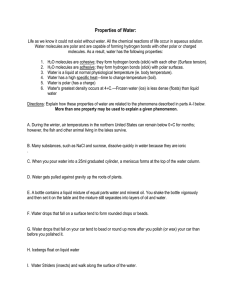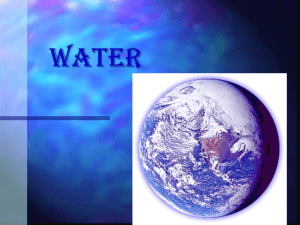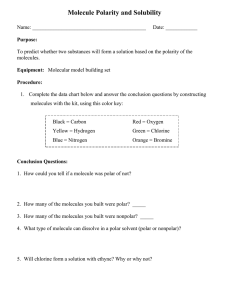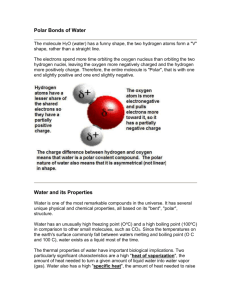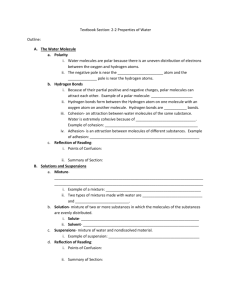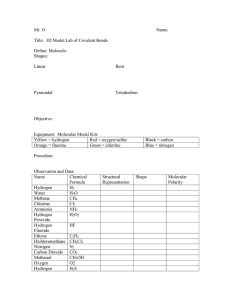CHAPTER 3- Water Unique Properties of Water Necessary for Living... Water facts: • 3/4 of earth is water
advertisement
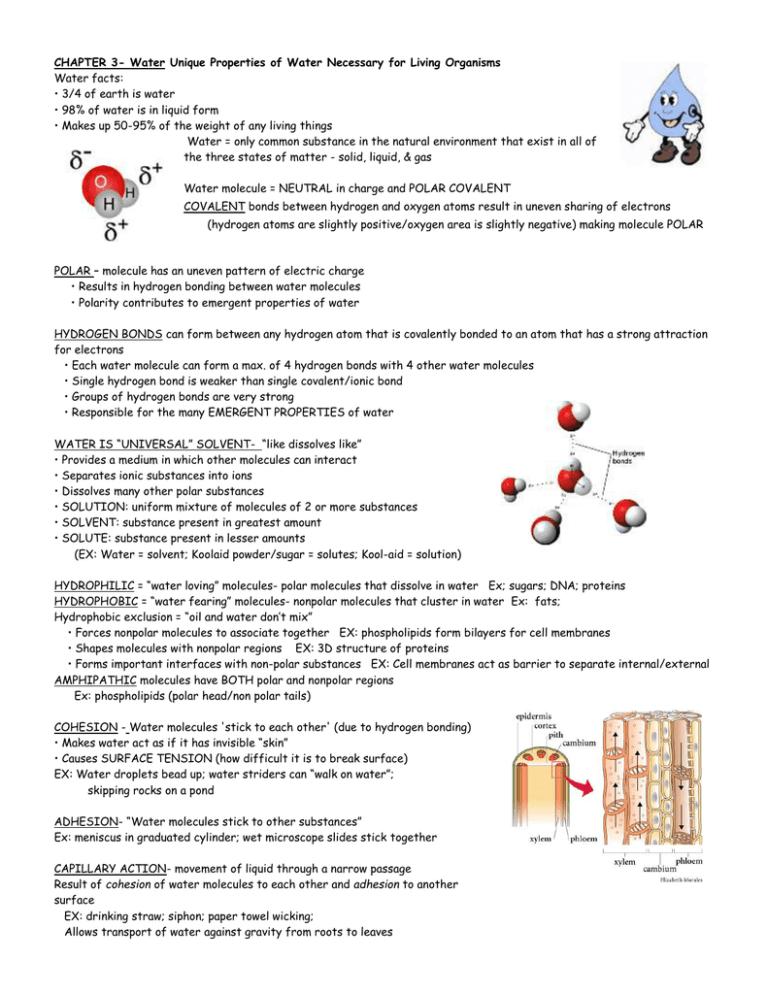
CHAPTER 3- Water Unique Properties of Water Necessary for Living Organisms Water facts: • 3/4 of earth is water • 98% of water is in liquid form • Makes up 50-95% of the weight of any living things Water = only common substance in the natural environment that exist in all of the three states of matter - solid, liquid, & gas Water molecule = NEUTRAL in charge and POLAR COVALENT COVALENT bonds between hydrogen and oxygen atoms result in uneven sharing of electrons (hydrogen atoms are slightly positive/oxygen area is slightly negative) making molecule POLAR POLAR – molecule has an uneven pattern of electric charge • Results in hydrogen bonding between water molecules • Polarity contributes to emergent properties of water HYDROGEN BONDS can form between any hydrogen atom that is covalently bonded to an atom that has a strong attraction for electrons • Each water molecule can form a max. of 4 hydrogen bonds with 4 other water molecules • Single hydrogen bond is weaker than single covalent/ionic bond • Groups of hydrogen bonds are very strong • Responsible for the many EMERGENT PROPERTIES of water WATER IS “UNIVERSAL” SOLVENT- “like dissolves like” • Provides a medium in which other molecules can interact • Separates ionic substances into ions • Dissolves many other polar substances • SOLUTION: uniform mixture of molecules of 2 or more substances • SOLVENT: substance present in greatest amount • SOLUTE: substance present in lesser amounts (EX: Water = solvent; Koolaid powder/sugar = solutes; Kool-aid = solution) HYDROPHILIC = “water loving” molecules- polar molecules that dissolve in water Ex; sugars; DNA; proteins HYDROPHOBIC = “water fearing” molecules- nonpolar molecules that cluster in water Ex: fats; Hydrophobic exclusion = “oil and water don’t mix” • Forces nonpolar molecules to associate together EX: phospholipids form bilayers for cell membranes • Shapes molecules with nonpolar regions EX: 3D structure of proteins • Forms important interfaces with non-polar substances EX: Cell membranes act as barrier to separate internal/external AMPHIPATHIC molecules have BOTH polar and nonpolar regions Ex: phospholipids (polar head/non polar tails) COHESION - Water molecules 'stick to each other' (due to hydrogen bonding) • Makes water act as if it has invisible “skin” • Causes SURFACE TENSION (how difficult it is to break surface) EX: Water droplets bead up; water striders can “walk on water”; skipping rocks on a pond ADHESION- “Water molecules stick to other substances” Ex: meniscus in graduated cylinder; wet microscope slides stick together CAPILLARY ACTION- movement of liquid through a narrow passage Result of cohesion of water molecules to each other and adhesion to another surface EX: drinking straw; siphon; paper towel wicking; Allows transport of water against gravity from roots to leaves • Density = mass of the material in a given volume • Density of liquids increases as temp goes down so most substances are MORE dense than as solids than as liquids • Water molecules move slowly and come close together so every molecule forms 4 hydrogen bonds SO . . . ICE IS LESS DENSE THAN LIQUID WATER (one of few substances where solid is less dense than liquid) Hydrogen bonds keep molecules “at arm’s length” when freezing so ice floats (protects aquatic ecosystems) EX: Insulation of bodies of water by floating ice lakes freeze from top down; allows living things to survive in winter when lake/pond freezes HEAT: • Kinetic energy = energy of motion • Heat = total amount of energy in a system •Temperature = measure of the average kinetic energy of in molecules EX: Swimmer in cold lake has a higher temperature than the water, but the lake contains more heat because of its volume. • calorie = the amount of heat needed to raise the temperature of water by 1oC.; • Energy in food measured with Calorie (= kilocalorie) 1000 calories HIGH SPECIFIC HEAT - amount of heat a substance needs for a given increase of temperature (hydrogen bonding-restricts movement) • Takes a lot of energy to raise 1 g of water by 1° C because must break Hydrogen bonds • Liquid H2O can absorb large amounts of heat with small changes in temperature • Heats up more slowly and retains heat longer than surroundings EX: Constancy of temperature for organisms (homeostasis) HIGH HEAT OF VAPORIZATION• Takes a lot of energy to convert liquid H2O into vapor (hydrogen bonding-restricts movement) • Vaporization (evaporation): change from liquid to gas; Molecules of liquid escape and enter air • Evaporation of water produces cooling effect EX: Some organisms sweat/pant to cool off when hot (EVAPORATIVE COOLING) pH SCALE- "power of Hydrogen • pH scale: scale that measures degrees of acidity • 1-14 scale measures hydrogen ion (H+) concentration; NEUTRAL = pH 7 • Each difference in one pH unit represents at 10X difference in the H + concentration (pH 2 has 1000 times more H+ ions than a pH 5) • Acid: substance that causes increase in H+ ions (pH less than 7) • Base (alkaline) = substance that causes increase in OH- ions (pH greater than 7) pH = -log 10 [H+] If [H+] = 1 X 10-7 then pH = 7 [H+] x [OH-] = 10-14 If [H+] = 1 X 10-9 then [OH-} = 10-5 pH = 9 pOH = 5 DISSOCIATION OF WATER MOLECULES- come apart and form charged ions H2O ---> H+ + OH- (ionization of water) H3O+ = Hydronium ion 1 out of 554,000,000 water molecules dissociates at equilibrium in pure water at 25oC [H+] = [OH-] = 1.0 x 10-7 M pH = 7 neutral CARBONIC ACID - BICARBONATE BUFFER SYSTEM Most important buffer for maintaining acid-base balance in the blood BUFFERS = weak acids or weak bases that act by combining reversibly with H + • Minimize changes in the concentrations of H+ and OH• Act as reservoirs for H+ • Can donate H+ to solutions when concentration falls • Can remove H+ from solutions when concentration increases • Control chemical reactions • Maintain homeostasis BICARBONATE BUFFER SYSTEM IN BLOOD - Major buffer system in blood Maintains blood pH between 7.38 and 7.42 • HCO3- = Bicarbonate (weak base) • H2CO3 = Carbonic acid (weak acid) • are in equilibrium H2O + CO2 ← → H2CO3 ← → HCO3— + H+ ACTION • • • • Strenuous exercise Fatty acid metabolism Acidic drug overdose (aspirin) Hyperventilation EFFECT INCREASE IN [‘H+] DECREASE pH BUFFER’S RESPONSE Equilibrium shifts to left H2O + CO2 ← H2CO3 ← HCO3- + H+ REMOVE CO2 BODY ORGANS HELP MAINTAIN BALANCE TOO: • Brain signals lungs to breathe more deeply and slowly → removes more CO2 to raise pH • Kidneys remove HCO3— causes shift to right and pH decreases (H+ increases) TREATMENT FOR HYPERVENTILATION • Breathe into paper bag → increases CO2 and shifts equilibrium to right TREATMENT FOR ACIDOSIS Patients given HCO3— causes shift to left and pH increases (H+ decreases)

